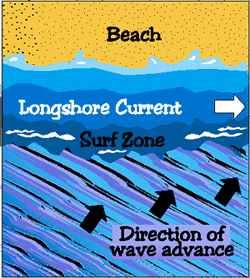Coastal Landforms and ProcessesA coast or the coastal zone is a dynamic region where land is sculpted and shaped by wave action and currents. Barring the effects of tectonic uplift and sea level change, erosion is the dominate geomorphic process acting on coasts. Coastal sediments are subject to multiple episodes of erosion, transportation and deposition, though a net seaward transport takes place on a global scale. The deep ocean floor becomes the resting place for terrestrial sediment eroded from the land. The combined effect of waves, currents and tides result in a variety of gradational processes acting in the coastal zone. Most important is abrasion, caused by the scraping or impact of sediment carried by water thrown against shore materials. Breakers are particularly effective at lifting larger rocks and hurling them against the shore. Hydraulic action caused by the direct impact of waves on the coast can be an effective geomorphic agent. Enormous pressures can build as water and air are compressed into rock fractures. Solution is locally important especially where soluble rock is exposed along the shore.
The water level in the surf zone increases as waves
approach shore at an angle. The rising water moves parallel to the shore
as a longshore current. Beach drifting transports sand
grains along the beach as waves strike the shore at an oblique angle.
Sediment is carried landward when water rushes across the beach as
swash. Sediment is carried back toward the ocean as
backwash.
The continual up rush and backwash carries sand in a zig-zag like
movement along the shore. |
 Figure 21.12 Longshore current in the surf zone. (Courtesy
Figure 21.12 Longshore current in the surf zone. (Courtesy